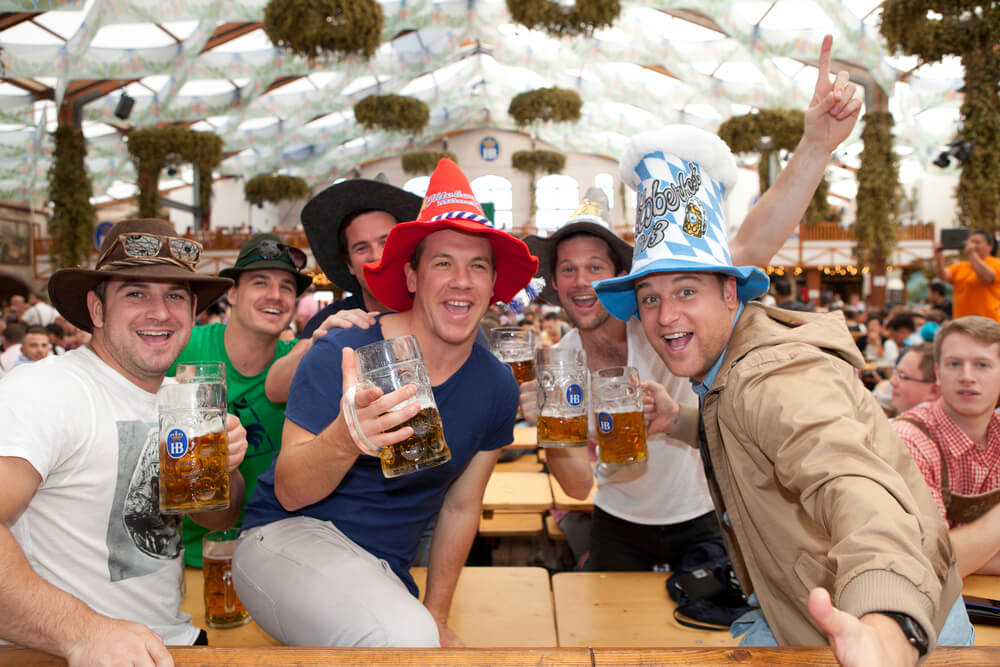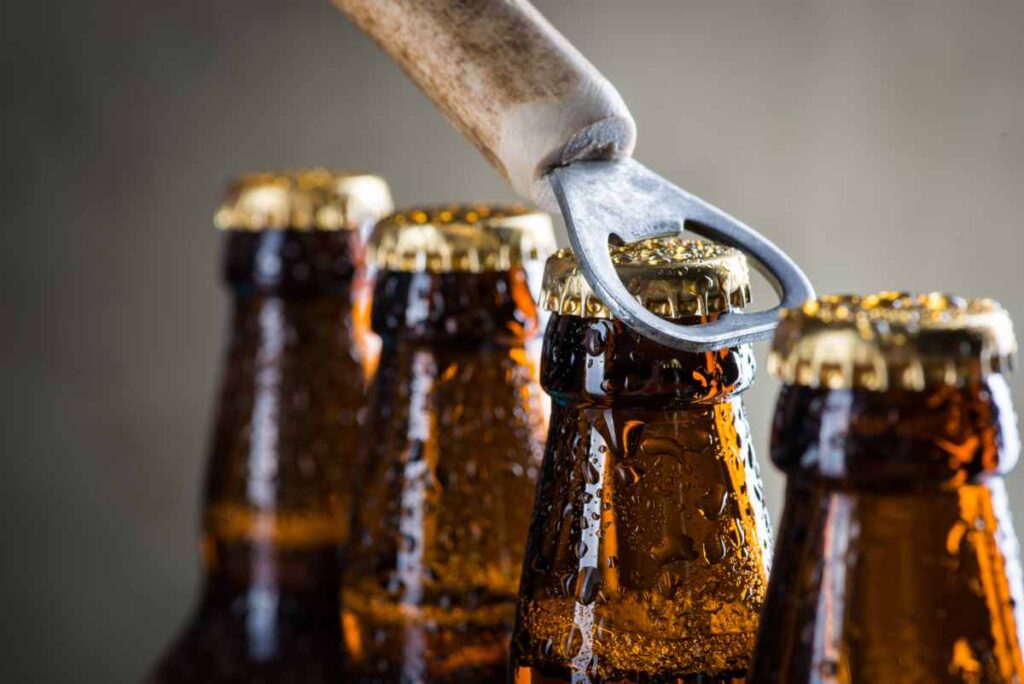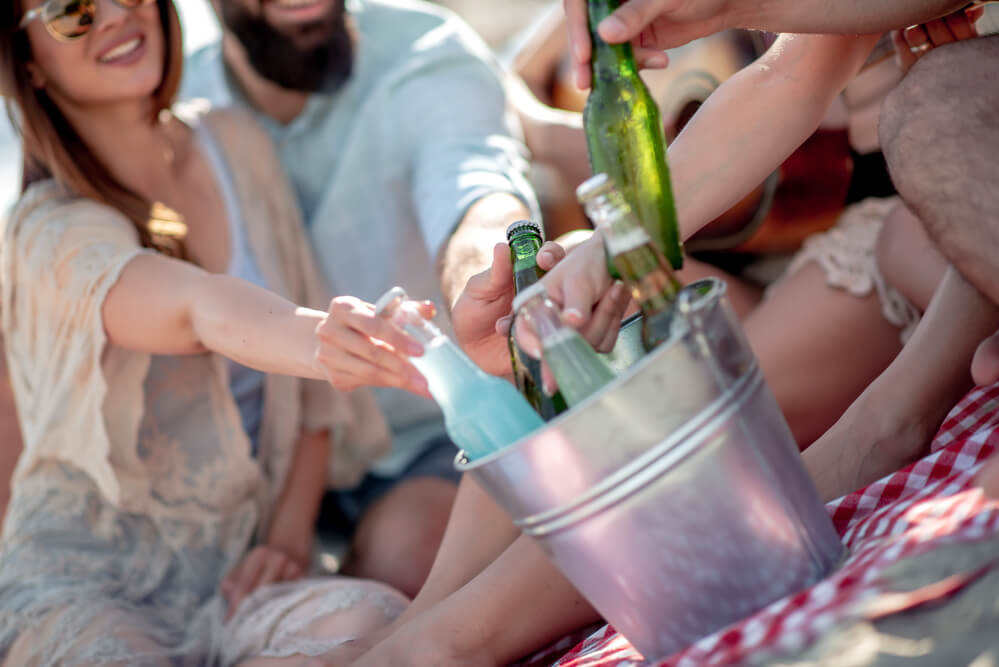What is a Dunkel? In this article, you will learn interesting facts about Dunkel.
Dunkel, a German word meaning “dark”, refers to a traditional bottom-fermented lager style beer that has been cherished by beer enthusiasts worldwide. This classic German lager originated in Bavaria and boasts a rich, dark color along with a unique taste profile that strikes a perfect balance of chocolate, bread crust, and caramel flavors.
This centuries-old beer variety relies on the use of Munich malts, which not only bestows the beer with its iconic dark hue but also serves as the foundation for its distinctive taste. Generally, Dunkel beers have alcohol concentrations ranging between 4.5% to 6.0% by volume. These dark lagers have their roots intertwined with the murky beginnings of Bavaria’s brewing history, and yet they continue to be a popular choice for craft brewers and beer aficionados alike.
Table of Contents
Origins and History
The Dunkel, meaning “dark” in German, is a type of dark German lager that originated in Munich, Bavaria. It typically ranges in color from amber to dark reddish-brown and is known for its smooth, malty flavor source.
Historically, the dark lagers of Bavaria, including the Munich Dunkel, were all brewed in a similar way and likely had a very murky, dark common ancestor source. The brewing tradition in Bavaria dates back to the Benedictine monks, who were among the first to produce these dark lagers in their monasteries source.
The development and improvement of brewing techniques can be attributed to the Reinheitsgebot or the Bavarian Beer Purity Law of 1516. This law stipulated that only three ingredients should be used for brewing beer: water, barley, and hops source. It was later amended to include yeast, which plays a crucial role in beer fermentation. The Reinheitsgebot helped ensure the quality and consistency of German beers, including the Munich Dunkel, and set high standards in the brewing industry.
Over time, Munich Dunkel evolved into a distinct style of beer with its malty flavor, balanced by the bitterness of hops. Today, the Munich Dunkel continues to be a popular choice among beer enthusiasts for its rich taste and historical significance.
Characteristics and Flavor Profile

Dunkel beer is a distinctive dark-colored lager with a rich, malty flavor profile. It has a relatively low alcohol content, rarely exceeding 5.5% ABV, and is known for its low bitterness 1. The aroma of Dunkel beer typically consists of chocolate roasted malt and bread or biscuit-like characteristics, stemming from the use of Munich malt 2.
The flavor profile of Dunkel is malt-forward, often showcasing notes of nuts, toffee, freshly baked bread, chocolate, and even licorice [^5^]. Despite the abundance of malt flavors, Dunkel does not have an overly sweet taste, which is one of its key characteristics. Some variations of Dunkel beer may also exhibit slight caramel, chocolate, toast, or nuttiness, adding depth and complexity to its flavor [^4^].
The bitterness level in Dunkel beers is moderate, with International Bitterness Units (IBUs) typically in the low 20s. This helps to balance out the malt-forward flavors and prevents the beer from becoming too sweet. Additionally, hop aromatics are subtle, allowing the malt flavors to take center stage [^5^].
In terms of appearance, Dunkel beer has a deep amber to dark brown color, which contributes to its overall visual appeal. The beer is often described as smooth and easy to drink, with a moderately low carbonation that complements its malt flavors.
To sum it up, Dunkel beer is characterized by its dark color, low bitterness, and rich malt flavors that include chocolate, bread crust, toffee, and nutty notes. The aroma is reminiscent of chocolate roasted malt and bread, while the taste is not overly sweet. Dunkel’s smooth and easy-drinking nature, combined with its unique flavor profile, make this beer type an enjoyable choice for those who appreciate malt-forward lagers 3.
Styles and Variations
Dunkel, meaning “dark” in German, is the original style of lager, originating in and around Bavaria. This dark beer has served as a forerunner to the pale lagers of today, making it quintessential to the history of beer. Let’s explore some of the variations and other styles often associated with Dunkel.
Munich Dunkel is a classic example of a German-style Dunkel. It features smooth, rich, and complex flavors of chocolate, bread crust, and caramel, which are well-balanced by its slight bitterness. Munich Dunkel is bottom-fermented and usually has an alcohol content that does not exceed 5.5% ABV.
Bock is another dark beer style, originating from Germany as well, and tends to be stronger and richer than Dunkel. Bocks usually have a higher ABV, starting around 6%, and a more pronounced malty sweetness. There are several variations of Bock, including Helles (pale) Bock and Doppelbock.
Doppelbock is a stronger version of Bock, with an ABV ranging from 7% to 12%. These beers are known for their intense malty flavors and often display fruit notes such as raisins, plums, or figs. Doppelbocks have a rich history, originally brewed by monks as nutritious sustenance during fasting periods.
Schwarzbier is another type of German dark lager, translating to “black beer.” This style is characterized by its deep color, roasted malt flavors, and a light body with moderate bitterness and crisp finish. While similar in color to Dunkel, Schwarzbier has a distinctively different flavor profile.
Dark Wheat Beers, such as Dunkelweizen and Weizenbock, are wheat-based beers with darker color and richer flavors compared to their lighter counterparts. These beers can have notes of banana, clove, and even chocolate, along with the characteristic wheat tartness.
In contrast, Helles is a pale lager that has outshined Munich Dunkel in terms of consumption in Munich. Although lighter in color and body, it shares the same balanced flavor profile, crispness, and refreshing nature that defines the German lager varieties.
In conclusion, Dunkels and their variations offer a delightful world of flavors, aromas, and appearances for those looking to explore the darker side of German beer styles. Whether you’re a fan of the classic Munich Dunkel or eager to try a robust Doppelbock, there’s a dark beer style for every palate.
Brewing Process and Ingredients
The brewing process for a Munich Dunkel starts with the selection of its distinct ingredients. The foundation of this beer lies in its flavorful Munich malt that provides a rich, toasty, and slightly sweet profile. Munich Dunkel primarily consists of Munich malt, and may also include small amounts of other roasted malts to achieve a deep color and enhance its overall complexity.
The lager yeast used for fermenting Dunkel contributes to the beer’s smooth, clean finish. Commonly used yeast strains for this style include White Labs WLP833 (German Bock Lager), Wyeast 2487 (Hella Bock Lager), or Mangrove Jack’s M76 (Bavarian Lager) 3.
When it comes to hops, Munich Dunkel typically utilizes noble hops, providing a subtle and balanced bitterness. The International Bitterness Units (IBU) generally falls within the range of 18-28, ensuring that the malt flavor remains the star of this beer1.
The water used in the brewing process plays a significant role in the final outcome of this style. Munich’s water profile is relatively high in carbonates, which can accentuate the malt flavors and enhance the beer’s overall character.
During the brewing process, the Munich malt and roasted malt (like Carafa) are steeped in water for around 30 minutes3. The temperature usually maintained throughout the mash process is 158 °F (70 °C) for optimal extraction of flavors, sugars, and enzymes from the grains. The wort is then boiled, and hops are added for bittering.
In terms of appearance, Munich Dunkel has a deep brown color with a slight reddish hue. The beer displays moderate to low carbonation and boasts a creamy, off-white head2.
The flavor profile of this beer revolves around its malty backbone, with toasty, bready, and caramel notes standing out. You may also detect hints of coffee, chocolate, and nutty flavors, but these are usually subtle. It’s important to keep the roasted character under control, as excessive roastiness could make it resemble a stout, which is not the intended outcome for this style2.
In summary, Munich Dunkel is a classic German beer that showcases the delightful characteristics of Munich malt while utilizing lager yeast and noble hops to achieve a smooth, balanced, and enjoyable drinking experience.
Notable Dunkel Beers
One fine example of a Dunkel beer is the Ayinger Altbairisch Dunkel. Originating from Bavaria, this beer showcases the traditional characteristics of a Dunkel: low bitterness, dark color, and malty flavor. With a confident, knowledgeable tone, we recommend this beer to anyone looking for an authentic Dunkel experience.
Another remarkable Dunkel beer is the Erdinger Dunkel. Known for its rich and complex flavor profile, Erdinger Dunkel is a popular choice among dark beer enthusiasts. Its distinctiveness lies in its smooth balance of roasted malt and mild hops, making it a delightful beverage to savor.
Hacker-Pschorr Münchner Dunkel is yet another noteworthy example of the Dunkel style. This beer from Munich embodies the old-fashioned brewing techniques that define Dunkel beers. With a combination of dryish chocolate or licorice notes, this beer has a unique and interesting taste that sets it apart.
Löwenbräu Dunkel is a classic, easy-drinking beer showcasing the traditional Dunkel characteristics. With its deep amber hue, malty sweetness, and low bitterness, this beer is a great introduction to the world of Dunkel for those who are new to the style.
Spaten München Dunkel is a beer that carries on the legacy of Munich’s dark lager tradition. Its balanced flavor profile features a smooth combination of roasted malt, caramel, and a light hop bitterness. This makes it an appealing choice for those who appreciate a well-rounded beer.
Lastly, Moondoor Dunkel is a modern take on the classic Dunkel beer. Its rich, dark color and malty flavor demonstrate a true appreciation for the style’s origins. While maintaining the key aspects of a Dunkel, this beer also ventures into new territory with subtle twists and variations.
These notable Dunkel beers showcase the rich history, diverse flavors, and time-honored brewing techniques associated with this classic style. Whether you’re a seasoned dark beer fan or new to the world of Dunkel, these selections are sure to impress and delight.
Global Popularity and Adaptations

Dunkel, the original dark European lager, has gained global popularity over the years. Originating in Bavaria, it has a rich history and has made its way into the repertoire of microbreweries and craft brewers in the United States and other countries. Its distinct characteristics have made it an appealing choice for beer enthusiasts worldwide.
This reddish-dark beer has a unique flavor profile that sets it apart from other beer styles like ales and hefeweizen. Dunkel lager is known for its malty, caramelized taste, often accompanied by notes of nuts or dark fruit. These tasty attributes, combined with the smooth and crisp nature of German lagers, make it a popular choice among beer connoisseurs and casual drinkers alike.
In the United States, the rise of microbreweries and craft brewers has led to an increase in demand for diverse beer styles. As a result, American craft brewers have experimented with and adapted Dunkel recipes to cater to local tastes. Some American breweries have even incorporated ingredients like chocolate or coffee to add to the existing flavor profile.
Oktoberfest, the annual beer festival held in Munich, Germany, has also contributed to Dunkel’s global popularity. Event attendees from around the world have the opportunity to experience and appreciate traditional German lagers, including the Franconian Dunkel. This exposure has ignited interest in the beer style and encouraged many breweries to try their hand at producing it.
Dunkel has also found a niche market in Mexico, where its dark color and malty taste resonate with local preferences for dark beers. Mexican breweries have embraced the style and produce their own versions of Dunkel, often incorporating local flavors and ingredients to create a unique take on the classic German lager.
In conclusion, Dunkel’s global popularity and adaptations can be attributed to the beer’s distinct taste and versatility. Microbreweries and craft brewers—whether in the United States, Mexico, or elsewhere—continue to explore this beer style, cementing Dunkel’s place as a staple in the world of beer.
Food Pairings and Serving Suggestions
Dunkel, a German-style dark lager, is characterized by its malty flavor, Munich malts, and chocolate-like aroma. This easy-to-drink beer is highly versatile when it comes to food pairings, making it a popular choice for many culinary enthusiasts.
Starting with traditional German dishes, Dunkel is known to pair well with various sausages. The robust maltiness complements the rich and savory flavors of the meat. Additionally, the beer’s Franconia roots make it a fitting match for hearty, regional dishes from the heart of Germany.
An interesting pairing to consider is Augustiner Dunkel with foods that have a hint of sweetness, such as barbeque sauce. The chocolate and coffee notes in the beer balance nicely with the tangy and sweet profiles of the sauce.
For fans of seafood, try pairing Dunkel with dishes like mussels or monkfish wrapped in pancetta. The beer’s underlying bitterness cuts through the richness of the fish, while the dark flavors complement the smoky pancetta.
When exploring international cuisines, Dunkel also pairs well with dishes such as beef in black bean sauce. The umami flavors of the sauce are mirrored by the beer’s malty character, making for an enjoyable dining experience.
In terms of serving suggestions, Dunkel is best enjoyed at a slightly chilled temperature. This allows the beer to maintain its crisp and refreshing finish, setting the stage for various food pairings.
One notable example of this style is Chuckanut Brewery’s Dunkel. This craft beer stands out with its bread-like characteristics, stemming from the use of Munich malt. When paired with freshly baked bread, these complementary flavors provide the ultimate comfort-food experience.
In summary, the malty profile and easy-to-drink nature of Dunkel make it a versatile choice for food pairings, from traditional German sausages to international dishes. Enjoying this beer with a range of foods will undoubtedly enhance your dining experiences.
Dunkel in the Modern Beer Landscape
Dunkel, a bottom-fermented German lager, remains a classic style, maintaining its significance in today’s beer landscape. Its popularity stems from low bitterness, a captivating dark color, and a distinct malty flavor. Dunkel’s relatively low alcohol by volume (ABV)—usually not exceeding 5.5%—adds to its appeal as a refreshing option.
While the term “dunkel” means “dark” in German, it is essential to understand the differences between dunkel and other dark beer styles like märzen and schwarzbiers. Märzen, a beer typically associated with Oktoberfest, is a medium-bodied amber-colored lager with a higher malt profile. Meanwhile, schwarzbiers, or “black beers”, are darker than dunkels and possess roastier flavors. Dunkels stand out with their signature combination of malt sweetness, mocha notes, and lighter body, making them an accessible choice for both seasoned enthusiasts and Americans exploring German beer styles.
Bavarian brewing tradition lies at the heart of dunkel beers. They often incorporate German lager yeast and noble hops like Hallertau, contributing to their unique flavor profile. The eye-catching dark hue is a result of utilizing darker malts or even a small percentage of roasted rye in the brewing process. This lends additional depth and complexity to the beer’s overall character.
Despite the continued production and consumption of dunkel beers, they face fierce competition with the plethora of modern styles dominating the market. Nevertheless, they retain a loyal fan base and can be found in breweries and beer bars worldwide. Dunkel’s solid foundation in Bavarian heritage combined with its refreshing and approachable nature keeps this style relevant and enjoyable in the modern beer landscape.



